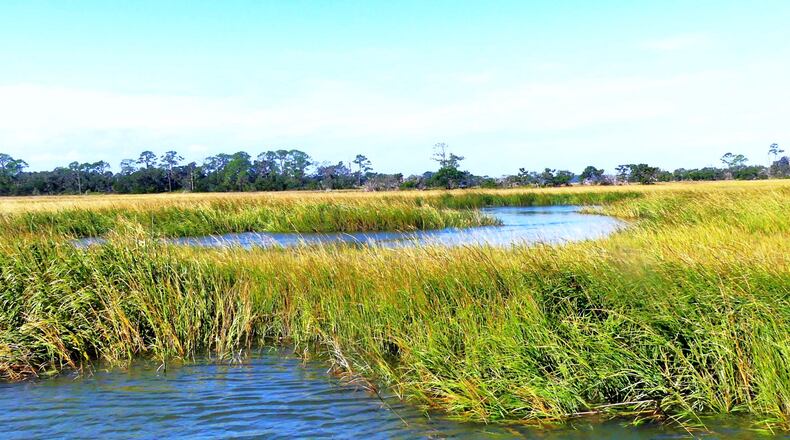Many a writer has tried to capture in words the vast, majestic beauty of Georgia’s coastal marshlands, not the least of whom was Sidney Lanier. The celebrated 19th century poet from Macon was dying from tuberculosis in 1898 when he wrote his penultimate poem, “The Marshes of Glynn.”
“Oh, what is abroad in the marsh and the terminal sea? / Somehow my soul seems suddenly free / From the weighing of fate and the sad discussion of sin, / By the length and the breadth and the sweep of the marshes of Glynn.”
A 1907 copy of Lanier’s “Hymns of the Marshes” is among the many books crowding my bookshelves at home. It contains that poem and three others, all inspired by the Georgia coast, as well as seven photographs of the marshlands around Brunswick taken by Henry Troth.
The fact that these very same marshes photographed more than 100 years ago still remain mostly untouched today seems like a miracle. But in truth it wasn’t a divine act that saved them, it was a legislative one.
Back in 1970, when “save the planet” was still a new concept, a group of forward-thinking scientists, environmentalists, landowners and state legislators banded together to get the Coastal Marshlands Protection Act passed. As a result, Georgia has only 100 miles of coastline but 400,000 acres of coastal salt marsh — more than any other state on the East Coast.
In “Saving the Georgia Coast” (UGA Press, $22.95), Paul Bolster, an Atlanta historian and former state legislator, chronicles how the act came to be and introduces the colorful cast of characters who made it happen.
Unfortunately for Bolster, his book published the very same week the whole country shut down for the COVID-19 pandemic, so all his author events were canceled. Three years later, he finally gets a chance for a do-over with an event at the Jimmy Carter Presidential Library on Jan. 17.
Based on a few humorous anecdotes in the introduction, Bolster makes it clear from the start that he’s no avid outdoorsman. But like many a weekend warrior, he has a deep appreciation for nature.
Credit: UGA Press
Credit: UGA Press
“There is an overwhelming need for us urbanites to find a wild place to be every once in a while,” he said.
For “Saving the Georgia Coast,” Bolster, who served in the state House of Representatives from 1974 to 1986, focuses not on the natural habitat of the marshlands but on the legislative process that created the act and the evolution of the political movement that made it happen.
The primary thing the Coastal Marshlands Protection Act accomplished was to prevent heavy industrial use of the coast in exchange for protecting marine life and controlled tourism. It created a permitting process and an agency empowered to manage requests to disturb the marsh.
As Bolster’s book attests, the act’s passage can be attributed to many factors. One of them was timing. Rife with war, riots and assassinations,1968 was a particularly tumultuous year in American history, but it ended on a high note. On Christmas Eve, astronaut Bill Anders was orbiting the moon in Apollo 8 when he snapped a photograph of the Earth in space. The image, known as “Earthrise,” shook the nation when it was published. No one had seen our planet from that perspective before, and suddenly it seemed vulnerable and its resources finite. Environmental protection efforts were beginning to gain traction at that time, and the photo became their symbol.
That same year, a tremendous amount of phosphate was discovered beneath Georgia’s marshlands, and the Kerr-McGee energy company was eager to mine it. The state was forced into making a decision about the future of its coastline, which set into motion a host of players invested in protecting it.
Key among them was attorney Reid Harris, the state representative from Brunswick who introduced the bill and was its biggest champion. (Harris has written his own book on the subject for UGA Press, “And the Coastlands Wait.”) Also integral to the effort were scientists at the University of Georgia Marine Institute, established on Sapelo Island in the 1950s. For 15 years they’d been collecting data that showed how vital the marshlands were to the ocean’s ecosystem.
But as Bolster details in his book, there were many others who played significant roles in the effort, and he gives them their due in “Saving the Georgia Coast.”
Nevertheless, there’s not a lot of resting on laurels going on because, as Bolster said, “one of the things about environmental legislation is, it’s never over.”
The law has morphed over the years. The Coastal Marshlands Protection Act no longer has its own enforcement agency. It’s now overseen by the coastal division of the Department of Natural Resources. Concerned citizens can no longer file a case for review, it has to be brought by someone directly affected.
Every year, said Bolster, there’s some legislation introduced that tries to alter the act’s protections.
“There’s always a desire for people to inch closer and closer to the sea,” he said.
Unfortunately, the biggest threat to the marshlands today is rising sea levels, and that seems beyond the realm of a legislative fix at this point in the game. But for now, Georgia’s marshlands remain mostly steadfast thanks to the efforts of many who fought to preserve them more than 50 years ago.
A Cappella Books presents Paul Bolster in conversation with Megan Desrosiers, president and CEO of One Hundred Miles, a coastal advocacy organization, at the Jimmy Carter Presidential Library at 7 p.m. Jan. 17. For details go to acappellabooks.com.
Suzanne Van Atten is a book critic and contributing editor to The Atlanta Journal-Constitution. You can contact her at suzanne.vanatten@ajc.com.
About the Author
Keep Reading
The Latest
Featured



